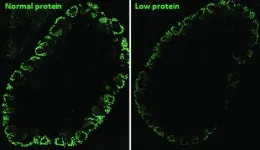(Press-News.org) (Philadelphia, PA) - For patients with chronic pain, ineffective treatments, lowered work productivity, and other factors often coalesce, fueling feelings of hopelessness and anxiety and setting the stage for even bigger problems, including substance use disorders. In 2017 alone, some 18 million Americans misused prescription pain relievers over the course of the previous year. In many of these instances, patients suffering from chronic pain became addicted to prescription opioids.
In addition to being highly addictive, many studies suggest that prescription opioids do not effectively control pain over the long term, and hence researchers have been exploring various alternatives, including cannabidiol (CBD). CBD is a non-psychoactive substance derived from the Cannabis plant.
Studies have shown that while CBD reduces pain sensation in animals, its ability to do so in humans is limited by low bioavailability, the extent to which the drug successfully reaches its site of action. Now, new work by scientists at the Lewis Katz School of Medicine at Temple University suggests this obstacle may be overcome by a novel CBD analog known as KLS-13019.
"In a mouse model of chemotherapy-induced peripheral neuropathy (CIPN), we've been able to show for the first time that KLS-13019 works as well as, if not better than, CBD in preventing the development of neuropathy and reversing pain sensitivity after pain has been established," said Sara Jane Ward, PhD, Assistant Professor of Pharmacology at the Katz School of Medicine and senior investigator on the new study. The findings were published online April 6 in the British Journal of Pharmacology.
KLS-13019, developed by the Pennsylvania-based bio-pharmaceutical and phyto-medical company Neuropathix, Inc., is among the most promising neuroprotective CBD analogs currently under investigation. In previous work in cell models, it was found to be more potent than CBD, and studies in animals suggested it had improved bioavailability.
Encouraged by those initial studies, Dr. Ward and colleagues set out to better understand the pain-relieving capabilities of KLS-13019, relative to CBD, in animals with CIPN. CIPN is a common side effect of certain cancer treatments that damage peripheral nerves, which carry sensory information to the arms, legs, and brain. The severe pain, or peripheral neuropathy, caused by CIPN manifests in different ways in human patients but frequently involves tingling or burning sensations and numbness, weakness, or discomfort in the limbs.
In a series of experiments designed to gauge animals' pain responses, the researchers found that pain sensitivity was greatly reduced in animals with CIPN that were treated with KLS-13019 or CBD. KLS-13019 further reversed sensitivity to painful stimuli in animals in which peripheral neuropathy was already established, an effect that was not observed in CBD-treated animals.
Earlier studies have also hinted at the possibility that CBD is able to reduce opioid craving in patients with opioid use disorder.
"Many patients who use opioids for pain management enter a cycle of reinforcement, where each use of opioids triggers reward pathways and perceived pain relief, leading to addiction," Dr. Ward explained.
While Dr. Ward and colleagues did not find evidence supporting a role for CBD in reducing opioid craving, they did observe significantly reduced opioid-seeking behavior in KLS-13019-treated animals.
"This tells us that KLS-13019 has benefits beyond its ability to alleviate pain," Dr. Ward said.
The researchers suspect that while likely sharing a mechanism with CBD for pain relief, KLS-13019 may have an additional mechanism of action, one that breaks up the pathways reinforcing opioid use.
In future work, Dr. Ward and her team plan to explore the mechanisms by which KLS-13019 exerts its effects, particularly those underlying the drug's ability to disrupt opioid-seeking behavior. They also plan to test the ability of KLS-13019 to alleviate other types of pain, beyond CIPN.
INFORMATION:
Other researchers who contributed to the study include Jeffery D. Foss, Daniel J. Farkas, and Lana M. Huynh, Center for Substance Abuse Research at the Katz School of Medicine, and William A. Kinney and Douglas E. Brenneman, Neuropathix, Inc., Pennsylvania Biotechnology Center, Doylestown, Pennsylvania.
The research was funded in part by National Institutes of Health grant R41 DA044898-01.
Many people with diabetes endure multiple, painful finger pricks each day to measure their blood glucose. Now, researchers reporting in ACS Sensors have developed a device that can measure glucose in sweat with the touch of a fingertip, and then a personalized algorithm provides an accurate estimate of blood glucose levels.
According to the American Diabetes Association, more than 34 million children and adults in the U.S. have diabetes. Although self-monitoring of blood glucose is a critical part of diabetes management, the pain and inconvenience caused ...
At the beginning of the COVID-19 pandemic, intense social distancing and lockdown measures were the primary weapon in the fight against the spread of SARS-CoV-2, but they came with a monumental societal burden. New research from the Center for the Ecology of Infectious Diseases and the College of Public Health at the University of Georgia explores if there could have been a better way.
Published in the journal Proceedings of the Royal Society B, the research analyzes more palatable alternatives to the kind of social distancing mandates that threw a wrench at how businesses, schools ...
A study published in July 2020 hypothesized a link between the presence of bradykinin, a well-known peptide, and severe cases of COVID-19. Vardan Karamyan, Ph.D., an associate professor and vice chair for the Texas Tech University Health Sciences Center (TTUHSC) Jerry H. Hodge School of Pharmacy Department of Pharmaceutical Sciences, had not previously conducted or evaluated any research related to COVID-19. However, he found the article intriguing because it discussed bradykinin, one of three specific peptides with which his lab has much well-published experience.
The paper received a lot of attention in both the media and scientific literature, but as Karamyan read through it, he felt it failed to address an equally important part of a bigger picture: the likely ...
A new service piloted at Penn Medicine allowed a proportion of patients to avoid hospitalization by providing them with greater support after visiting the emergency department. The vast majority of the patients enrolled in the service - nearly 9 out of 10 - did not need to return to the hospital for care in the month that followed their initial visit. The study was published in Healthcare.
"The culture is shifting where we realize that hospitalization is not always the best option for patients - particularly patients with chronic illness," said one of the study's lead authors, Austin Kilaru, MD, an emergency physician at Penn Medicine. "We need to find better ways of helping patients not just get healthy in a hospital, but stay healthy at ...
Leather is an ever growing multi-billion dollar industry requiring more than 3.8 billion bovine animals - equal to one for every two people on earth - to sustain production each year. And while the products - clothing, shoes, furniture and more - can be quite elegant and durable, the environmental impact of leather production has been severe, leading to deforestation, water and land overuse, environmental pollution, and greenhouse gas emissions.
Researchers at Tufts University School of Engineering set out to find an alternative to leather, with similar texture, flexibility and stiffness, yet focused on materials that are sustainable, non-toxic, and friendly to the environment. It turns out, we have been wearing that material ...
PITTSBURGH, May 5, 2021 - Subtle differences in the shape of the brain that are present in adolescence are associated with the development of psychosis, according to an international team led by neuroscientists at the University of Pittsburgh School of Medicine and Maastricht University in the Netherlands.
In results published today in JAMA Psychiatry, the differences are too subtle to detect in an individual or use for diagnostic purposes. But the findings could contribute to ongoing efforts to develop a cumulative risk score for psychosis that would allow for earlier detection and treatment, as well as targeted therapies. The discovery was made with the largest-ever ...
Besides being underweight, babies born to women whose diet lacked sufficient protein during pregnancy tend to have kidney problems resulting from alterations that occurred while their organs were forming during the embryonic stage of their development.
In a study published in PLOS ONE, researchers affiliated with the University of Campinas (UNICAMP) in the state of São Paulo, Brazil, discovered the cause of the problem at the molecular level and its link to epigenetic phenomena (changes in gene expression due to environmental factors such as stress, exposure to toxins or malnutrition, among others).
According to the authors, between 10% and 13% of the world population ...
Researchers from the University of Liverpool have shown the potential of repurposing an existing and cheap drug into a long-acting injectable therapy that could be used to treat Covid-19.
In a paper published in the journal Nanoscale, researchers from the University's Centre of Excellence for Long-acting Therapeutics (CELT) demonstrate the nanoparticle formulation of niclosamide, a highly insoluble drug compound, as a scalable long-acting injectable antiviral candidate.
The team started repurposing and reformulating identified drug compounds with the potential for COVID-19 therapy candidates within weeks of the first lockdown. Niclosamide is just one of the drug compounds identified and has been shown to be highly effective against SARS-CoV-2 in a number of laboratory studies.
Using ...
New Johns Hopkins University simulations offer an intriguing look into Saturn's interior, suggesting that a thick layer of helium rain influences the planet's magnetic field.
The models, published this week in AGU Advances, also indicate that Saturn's interior may feature higher temperatures at the equatorial region, with lower temperatures at the high latitudes at the top of the helium rain layer.
It is notoriously difficult to study the interior structures of large gaseous planets, and the findings advance the effort to map Saturn's hidden regions.
"By ...
The incorporation of boron into polycyclic aromatic hydrocarbon systems leads to interesting chromophoric and fluorescing materials for optoelectronics, including organic light-emitting diodes (OLEDS) and field-effect transistors, as well as polymer-based sensors. In the journal Angewandte Chemie, a research team has now introduced a new anionic organoborane compound. Synthesis of the borafluorene succeeded through the use of carbenes.
Borafluorene is a particularly interesting boron-containing building block. It is a system of three carbon rings joined at the edges: two six-membered and one central five-membered ring, whose free tip is the boron atom. While neutral, radical, and cationic (positively ...





